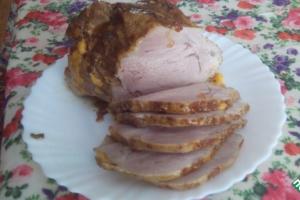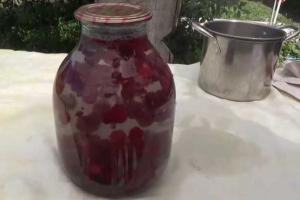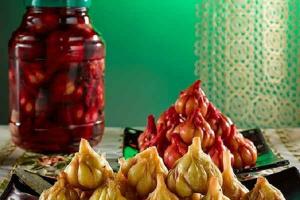Currants are most often propagated by cuttings or layering. Propagation by currant cuttings is of greatest practical importance. But the method of propagation by layering has also proven itself well, especially among amateur gardeners. Let's look at each of them in more detail.
Currant cuttings are parts of annual bush branches used for propagation. For this purpose, annual branches are cut from healthy, tall and productive mother currant bushes (black, white and red) of certain varieties. Currant cuttings are harvested in the fall after leaf fall or in the spring before the buds open. The best time for harvesting cuttings is autumn: from the beginning to the end of September.
Length of follow-up spring planting branches tied in bunches are stored in basements or cellars for the winter, buried in a reclining position in wet sand half their length. When snow falls, shards can also be stored on open place, burying them in bunches in the snow to a depth of approximately 60 - 80 centimeters. You can also harvest branches in the spring, just before planting, if they are not damaged by winter frosts.
In early autumn (late September, early October) or early spring, as soon as work in the garden can begin, currant cuttings are planted. Experiments and observations have shown that currant cuttings planted in the fall take root better than when planted in spring.
Before planting, the harvested branches are cut into pieces 20–25 centimeters long. Thus, from one long branch you can get several cuttings for planting. The lower cut on the cutting is made obliquely under the bud in order to obtain a larger area of the wound, since the root formation process is better on such wounds. The upper cut is formed directly above the kidney. Sections are made near the kidneys in order to bring the wounds closer to the points of the most active tissue in order to speed up healing. Root formation begins at the lower end of the cutting in the wound area.

Rice. 1 Correct fit currant cuttings
The prepared cuttings are planted immediately. When planting, the lower end of the cutting is lowered into loose soil to such a depth that only the bottom of the soil remains above the soil surface: one is level with the surface, and the other is higher (Fig. 1). After planting, the cuttings are watered abundantly to moisten the soil to the entire depth of the cuttings.
In the spring-summer period, the plantings are properly cared for - watering as needed, loosening, three to four times fertilizing with organic and mineral (nitrogen) fertilizers, pest and disease control. Covering the beds and rows with a layer of manure or humus two to three centimeters thick has a beneficial effect on the rooting of cuttings. By autumn, seedlings with two strong branches and with a good fibrous root system.
Reproduction of currants by layering
The method of propagation by layering is quite effective and has proven itself well among ordinary amateur gardeners. It can be divided into several subgroups: propagation by horizontal layering, propagation by arcuate layering, propagation by vertical layering.
Reproduction by horizontal layering

Fig 2. Reproduction of currants by horizontal layering
In early spring, around the mother currant bushes, carefully cultivate the soil and apply organic fertilizers. Then, with the beginning of sap flow, long annual branches are laid radially around the bush along furrows three to four centimeters deep or in a hole made near the bush six to eight centimeters deep and pinned, for example, with wooden pins (Fig. 2).
After some time, shoots will begin to develop from the buds of the spread branches. As soon as the latter reach 8-10 centimeters in height, they are spudded - covered with earth to a depth of approximately 5-6 centimeters along the entire length of the laid branch and watered.
After 10-15 days, they are spudded again with damp soil. In the spring-summer period, the cuttings must be looked after - loosen the soil, remove weeds and water as necessary, giving 8-10 buckets per bush, and then cover the soil with a layer of mulch.
On the hilled currant branches, strong shoots develop and roots form, which by autumn reach the necessary fibrousness. In the autumn, when the leaves fall and the growth of the branched shoots stops, they are cut off from the bush, dug out of the ground entirely and cut into pieces so that each part of the cutting has one well-developed shoot and root system.
New seedlings are sorted and planted in the school, where they grow into strong seedlings suitable for planting over the next growing season. This method of propagation is called horizontal or Chinese layering.
Reproduction by arcuate layering

Fig 3. Reproduction of currants by arcuate layering
When propagating currants, arcuate layering is used. With this method, annual branches in the spring, when buds begin to open, are bent in an arched manner to the ground, the bend is lowered into a hole 15–20 centimeters deep, covered with damp soil, and the top of the branch is tied to a peg to give it a vertical position (Fig. 3). For better root formation in arcuate layers, it is recommended to make small cuts (wounds) in the bark and wood on the backfilled part of the branch. In the fall, the allocated branches of the bush near the bend are cut and the rooted parts are dug up. Seedlings are planted in a nursery for growing for one year. Arc-shaped layering is less depleting of the mother bush.
Reproduction by vertical layering

Rice. 4 Propagation of currants by vertical layering
Currants are also propagated by vertical layering (Fig. 4). To do this, the mother bushes are pruned at the base in early spring at a height of 10 centimeters from the soil surface. In spring, powerful shoots develop from dormant buds. When they reach 15-20 centimeters in length, they are covered with 5-7 centimeters of loose, damp soil. Hill up again by 5 centimeters when the shoots grow another 10 centimeters. Towards the end of the growing season, the young shoots will develop roots underground. In autumn, the mother bushes are unplanted, the rooted branches are cut out and used as seedlings.
Currant seedlings obtained by any method of propagation must meet the standard for growth and development planting material. They must be well developed, completely healthy, have a branched root system of at least 20 centimeters in length and at least two shoots 20 centimeters high.
In addition to currants, all types and varieties of gooseberries can also be propagated using the above methods; they take root quite easily and produce new shoots.
Proper propagation of garden strawberries allows you to obtain the strongest and healthiest bushes, which will subsequently give a bountiful harvest.
Best harvest Strawberries are harvested from two- and three-year-old plants. In the fourth year, fruiting drops sharply, so plantings need to be renewed periodically. Gardeners usually propagate strawberries using Grandma's old method - at the end of fruiting, they select the largest rooted rosettes and transfer them to a new bed. However, to obtain the highest quality planting material, you should resort to a more reliable method - through queen cells.
What are queen cells?
Strawberries reproduce vegetatively - by rosettes that form on elongated shoots (tendrils). Whiskers development begins in the second half of summer,
growth and rooting of rosettes continues until autumn. Most quality seedlings obtained from queen cells, that is, from plants that are grown exclusively for propagation; berries are not collected from them. The most healthy, large-fruited, disease- and weather-resistant specimens become queen cells. To identify them, the mustaches are cut off from all strawberry bushes and wait for fruiting. Bushes suitable for propagation are transferred to a separate bed and grown separately. Next year they will already receive sockets from them.
Whiskers are not taken from fruiting plants. This is explained by most The bushes spend nutrients on ripening the berries, and only the remainder goes to the formation of the mustache. In this case, young sockets are defective. In addition, if a bush simultaneously spends energy on berries and runners, it becomes depleted faster, gets sick easily, and the yield decreases. Queen cells, not being able to produce seeds, devote all their energy to the formation of mustaches. Their seedlings are very strong and prolific.
How to care for queen cells?
The most fertile soils are selected for the queen cells, and they are planted farther apart so that there is enough space for the runners. About 90 cm is left between the rows, and 40 cm between plants. All flower stalks from the mother plants are torn off so that all the strawberry forces are directed to the formation of young rosettes. At proper care one plant can produce up to 30 tendrils. On the contrary, all tendrils are removed from fruit-bearing plants.
The soil on the queen cell is maintained in a loose state during the summer. The fertilizer includes ammonium nitrate 10-20 g per 1 sq. m. m and potassium sulfate up to 5 g per 1
sq. m. Watering is required, especially in July and August.
Mother bushes should be changed every 3-4 years.
How to care for young rosettes?
The largest, most developed first-order tendrils are selected from the numerous shoots, separated from the mother plant and planted in rows at a distance of 5-7 cm

from each other, leave 10-12 cm between the rows. For the first 3-4 days after planting, strawberries are watered daily, and then after 2-3 days, remembering to carefully loosen the soil so that a crust does not form.
After a week the plants take root, and after 3 weeks the seedlings are ready to be transplanted to permanent place. It is important to plant in late July - early August, so that the strawberries have time to take root in the new bed before the first frost.
Strawberries planted in the fall are very sensitive to frost, so they need shelter or mulching, as well as snow retention.
Strawberry- sweet, tasty and healthy berry, which every gardener grows on his own plot.
The most common and simplest way is propagation of strawberries by mustache.
Let's consider the features of reproduction garden strawberries mustache, how to choose the right bushes, root a rosette and transplant seedlings to a permanent place.
Sometimes gardeners try to simultaneously get a harvest from the bushes and use the same strawberry bushes for propagation. But this approach is not correct, the plants quickly become depleted, the strawberries produce a smaller harvest, begin to get sick, and the berries become worse in quality.

If you have strawberry bushes with good varietal qualities, make a choice: either you want to get a harvest of berries, or a mustache for propagation.
If you think that you can take mustaches from the bushes after harvesting berries, such seedlings will not be full-fledged, since the plants have already spent most of the nutrients to produce berries, the mustaches will be weak. Plants cannot be forced to work on two fronts; they will quickly exhaust their resources.
Video - Strawberry propagation by mustache
To obtain a high-quality strawberry bed, it is necessary to select the mother bushes - the key to proper propagation.

To do this, in the first year of planting strawberries, all the whiskers are removed from all bushes, waiting for the berry harvest.
Of all the plants, choose those that did not get sick, withstood the vagaries of the weather better, and with large berries of the same size.

Such bushes should be marked in various ways (with a stick, a sticker, a rag), the main thing is to be visible. These are future mother bushes. To avoid confusion, you can plant such bushes on separate beds, according to the scheme 40 cm between bushes and 80 cm between rows.
Next year, do not allow flowering on the mother bushes; remove all buds. Plants will put all their energy into developing whiskers. Already in June the bushes will begin to produce mustaches with rosettes. For reproduction, leave only powerful and large mustaches, remove all others.
Most best option – leave one outlet, closest to the mother bush. If there is a need for large quantities seedlings, you can also use second sockets.
When roots appear on the rosettes, there are two options for further development:

First option, you can pin the rosette to the ground, water and care for it without cutting it off from the mother bush, as you would with seedlings.

Second option It is considered best to plant each rosette in a separate pot with soil, where the root system will develop before replanting.

Transplantation occurs together with a ball of earth without damaging the root system, the plants quickly take root and take root in a new place.
2 weeks before transplanting to a new place, you should trim the mustache from the mother bushes so that they get used to feeding on their own. Plant the plants in a new permanent location in July-August. Strawberry seedlings will have time to form and grow stronger before the first frost.

Within 2-3 years you will receive strawberry seedlings. Bushes 2-3 summer age give more whiskers than in the first year.
Video - Super way to propagate strawberries
Here is such a simple and reliable way to propagate strawberries with mustaches. We hope the article will be useful to you when growing strawberries on your site.

Good luck to you and big harvests strawberries!
Strawberries- Probably the most labor-intensive berry in terms of agricultural technology. And this is her biggest drawback, which is compensated only by her divine taste. We have to invent all sorts of simplifications in order to spend on it less strength and time. One of the agrotechnical troubles is the need to renew plantings every 3–4 years, when you have to completely uproot old plantings, plant a new bed and prepare young planting material.
It is with this planting material that there is a lot of hassle. For example, one way to rejuvenate plantings is to use horns from old bushes. The method is not the most complicated, but it produces short-lived planting material. After all, the horns themselves are not in their first youth, and besides, they have accumulated diseases and pests. Therefore, the most reliable way of rejuvenation and reproduction is, as you know, planting rosettes. However, they are also a lot of trouble. Since growing rosettes sharply reduce the yield of the bush from which they originate, you need to catch the moment when the bush is not yet greatly weakened, but the rosettes have already grown and become strong enough, i.e. three good leaves have grown on them, and the roots are 5 cm long. At this time, it is customary to separate them and let them go into independent life. Sockets of the first and second orders need to be dug up and transplanted to a new place, and this is also quite a troublesome task.
 In order not to weaken the fruiting bushes, mother bushes are usually grown to propagate valuable varieties - this is another problem. Probably, for those who grow a lot of rosettes for sale, this method is very convenient. However, ordinary gardeners often have a ridge on which many varieties of strawberries grow, 2-3 bushes of each variety. And you want to continue to grow the best of them, which means you need to take the mustache from them. This is where gardeners begin to invent, coming up with ways to simplify and facilitate the method of growing young rosettes from mustaches. Most of them first root rosettes between the rows, and in August or early September they plant them in a prepared place.
In order not to weaken the fruiting bushes, mother bushes are usually grown to propagate valuable varieties - this is another problem. Probably, for those who grow a lot of rosettes for sale, this method is very convenient. However, ordinary gardeners often have a ridge on which many varieties of strawberries grow, 2-3 bushes of each variety. And you want to continue to grow the best of them, which means you need to take the mustache from them. This is where gardeners begin to invent, coming up with ways to simplify and facilitate the method of growing young rosettes from mustaches. Most of them first root rosettes between the rows, and in August or early September they plant them in a prepared place.
Since it takes ten days to root the transplanted rosettes, these days seem to be lost in the life of the plants, and therefore this method was invented: the rosettes are rooted not in the soil of the bed, but in cups filled with earth. When the rosettes in the cups “ripen”, they are separated from the “mother” and transferred with a lump of earth to the right place. The root system is not disturbed, the bushes quickly take root. In this way, about a week of time is saved, which the bushes spend in the future on their growth. This method is good when the bushes are grown under black film or roofing felt.
 Observant gardeners have noticed that high-quality seedlings can be grown from younger, not yet rooted rosettes taken from a one- or two-year-old bush. In this case, the fruit-bearing bushes are not depleted, and their productivity practically does not decrease. The rosettes are growing quite good quality. With this method, the mustache with barely visible tubercles of roots on the rosettes is cut off. The rosettes are planted, or rather pinned, in special nutritious soil and watered regularly. The plantings are covered with lutrasil so that they do not dry out during the rooting period. The rosettes quickly take root and begin to grow actively. After three weeks, normal seedlings grow. It is usually planted in place in the spring.
Observant gardeners have noticed that high-quality seedlings can be grown from younger, not yet rooted rosettes taken from a one- or two-year-old bush. In this case, the fruit-bearing bushes are not depleted, and their productivity practically does not decrease. The rosettes are growing quite good quality. With this method, the mustache with barely visible tubercles of roots on the rosettes is cut off. The rosettes are planted, or rather pinned, in special nutritious soil and watered regularly. The plantings are covered with lutrasil so that they do not dry out during the rooting period. The rosettes quickly take root and begin to grow actively. After three weeks, normal seedlings grow. It is usually planted in place in the spring.
Gardeners have simplified this method too. They invented a method of growing mustaches in containers of water. A basin is dug into the ground and filled with water. A bed with nutritious soil is made around its edges. The mustache is taken with a long “leg”, cutting it off near the “mother” itself. The end of the mustache is dipped into the water, and the rosettes are pressed into the bed. The basin is covered with a lid or film. Water is regularly added to it, making sure that the mustache does not come out of the water. By August, a clump of strawberries is growing green around the basin. This month it is already possible to plant the plants in place. This method is described by N.I. Kurdyumova. And many gardeners use it successfully.
But here, too, labor and time are required - digging a basin, then replanting the seedlings, waiting for the plants to take root. I tried to simplify this simple method, using all the findings from the previous methods. In parallel with the row of fruiting strawberries, I prepared a row with fertile soil. As soon as the first tendrils appear, I pull them back and pin the rosettes onto this new bed. As soon as the first root catches on the soil, I cut off the tendril near the “mother” itself and lower it into a glass of water dug near the bed. The glass is small, from a yogurt container, and it’s very easy to dig it in with one movement of a garden shovel. Usually one glass is enough for 2-3 mustaches. If there is no rain, I regularly add water to the cups and water the sockets. They take root and grow very quickly. There is no need to transplant them anywhere; they are already growing in place. This saves time on rooting and replanting the bush.
FRONTAL STRAWBERRY BRUSHES! Blackberry Premier Ark Freedom - mother bush in a container How to propagate many strong plants from one chrysanthemum mother bush!!! Planting scheme for mother currant bushes. FRUIT NURSERY from scratch. Part #4 Vozhenosky sockets of strawberries at the time of transplanting! How to properly divide the uterine of chrysanthemum a way of breeding strawberries mustache. Malina put a uterine root trough - a uterine sadfundance. We select a bush for seedlings on 03/30/18 perepassage of the blackberry bush with rooted vins. farm Batkiv Garden Echinodorus Rose. Peculiarities of propagation. Maravilla raspberry motherroot, cultivation experiment. Planting and growing mother bushes of the rootstock, Cober 5bb, CO - 4, PP101-14. MY SUPER METHOD OF STRAWBERRY PROPAGATION!!! SELECTING “FEMALE” ROSETS! Blackberry motherroot. Prime Arc Freedom. The result of the experiment. How the mother root of the raspberries Poemat, Pshehiba, Mapema was preserved in boxes on the street! The mother root of the Prime Arc Freedom blackberry / Nettle shoots The mother root, the result. START OF SEASON 2018








